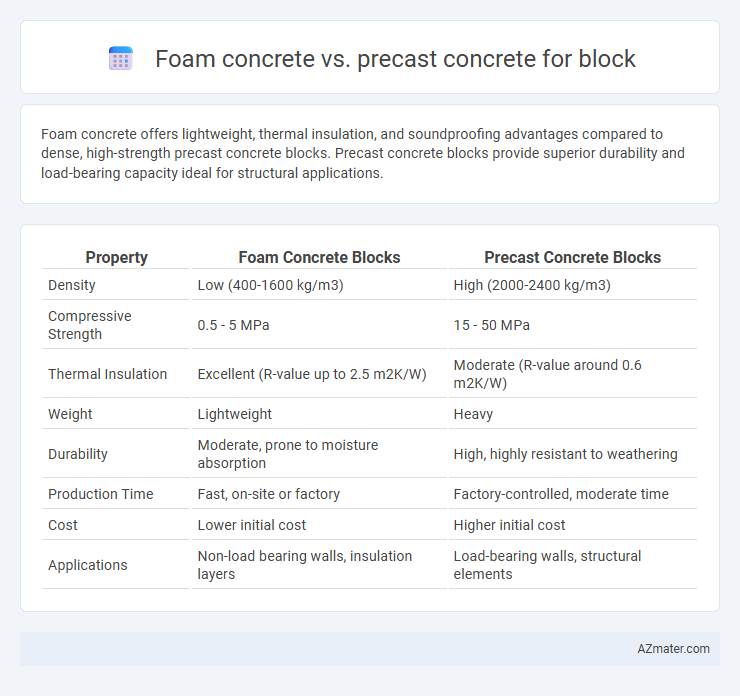Foam concrete offers lightweight, thermal insulation, and soundproofing advantages compared to dense, high-strength precast concrete blocks. Precast concrete blocks provide superior durability and load-bearing capacity ideal for structural applications.
Table of Comparison
| Property | Foam Concrete Blocks | Precast Concrete Blocks |
|---|---|---|
| Density | Low (400-1600 kg/m3) | High (2000-2400 kg/m3) |
| Compressive Strength | 0.5 - 5 MPa | 15 - 50 MPa |
| Thermal Insulation | Excellent (R-value up to 2.5 m2K/W) | Moderate (R-value around 0.6 m2K/W) |
| Weight | Lightweight | Heavy |
| Durability | Moderate, prone to moisture absorption | High, highly resistant to weathering |
| Production Time | Fast, on-site or factory | Factory-controlled, moderate time |
| Cost | Lower initial cost | Higher initial cost |
| Applications | Non-load bearing walls, insulation layers | Load-bearing walls, structural elements |
Introduction to Foam Concrete and Precast Concrete
Foam concrete is a lightweight, aerated material created by mixing cement slurry with stable foam, resulting in a block that offers excellent thermal insulation and reduced self-weight. Precast concrete, on the other hand, involves casting concrete blocks in controlled factory environments and curing them before transportation to the construction site, ensuring high quality and consistency. Both materials serve as structural and non-structural blocks, with foam concrete excelling in insulation and precast concrete known for superior strength and precision.
Material Composition and Properties
Foam concrete consists of cement, water, and a foaming agent that introduces air bubbles, resulting in lightweight material with high thermal insulation and reduced density ranging from 400 to 1600 kg/m3. Precast concrete blocks are made from a mixture of cement, aggregates, water, and admixtures, providing high compressive strength, durability, and uniform quality with densities typically between 2200 and 2500 kg/m3. The porous structure of foam concrete gives it superior thermal and acoustic properties, whereas precast concrete offers greater load-bearing capacity and dimensional stability for structural applications.
Manufacturing Process Comparison
Foam concrete is manufactured by mixing cement, water, fine aggregates, and a foaming agent to create a lightweight, aerated mixture that is poured into molds and cured at ambient temperatures. Precast concrete blocks are produced in controlled factory environments by casting dense concrete mixtures into reusable molds, followed by curing through steam or heat to achieve high strength and durability. The foam concrete process allows faster setting and reduced weight, while precast concrete offers superior structural integrity and uniformity due to precise curing conditions.
Structural Strength and Durability
Foam concrete offers lightweight properties with moderate compressive strength ranging from 3 to 20 MPa, making it suitable for non-load-bearing applications, while precast concrete blocks provide higher structural strength typically between 20 to 40 MPa, ideal for load-bearing walls and foundational elements. Durability of precast concrete surpasses foam concrete due to its dense matrix and controlled manufacturing process, resulting in enhanced resistance to weathering, chemical attack, and mechanical wear. Foam concrete's porous structure may compromise long-term durability under aggressive environmental conditions, whereas precast concrete blocks ensure greater longevity and structural reliability in construction projects.
Thermal and Acoustic Insulation Performance
Foam concrete offers superior thermal insulation due to its high air content and lightweight cellular structure, significantly reducing heat transfer compared to precast concrete blocks. Acoustic insulation is also enhanced in foam concrete blocks as the porous matrix absorbs sound waves, minimizing noise transmission inside buildings. Precast concrete blocks, while structurally strong, have higher density and lower porosity, resulting in less effective thermal and acoustic insulation properties.
Installation and Construction Speed
Foam concrete offers faster installation and construction speed due to its lightweight nature and self-leveling properties, allowing easier handling and quicker placement on-site compared to precast concrete blocks, which require crane equipment and precise alignment for positioning. Precast concrete blocks, while durable and uniform in quality, often involve longer lead times due to manufacturing and transportation logistics before on-site installation can commence. Choosing foam concrete can significantly reduce labor costs and accelerate project timelines in large-scale block construction projects.
Cost Analysis and Economic Considerations
Foam concrete blocks typically offer lower material and transportation costs due to their lightweight nature, reducing handling expenses and foundation requirements. Precast concrete blocks demand higher initial investment but provide faster installation times and superior durability, potentially lowering long-term maintenance costs. Economic considerations favor foam concrete for projects prioritizing cost-efficiency and thermal insulation, while precast concrete suits large-scale developments where strength and uniformity justify higher upfront expenditure.
Environmental Impact and Sustainability
Foam concrete offers significant sustainability benefits over precast concrete due to its lower density and reduced cement content, which decreases carbon emissions during production. Its lightweight nature improves thermal insulation, leading to energy-efficient building designs and reduced operational energy consumption. Precast concrete, while durable and recyclable, generally involves higher embodied energy and transportation emissions, making foam concrete a more environmentally friendly choice for sustainable block construction.
Applications in Building Projects
Foam concrete offers superior thermal insulation and lightweight properties, making it ideal for non-load-bearing partition walls and void filling in building projects. Precast concrete blocks provide high structural strength and durability, suitable for load-bearing walls, foundations, and exterior facades. The choice between foam and precast concrete depends on specific construction requirements such as insulation needs, load capacity, and installation speed.
Choosing the Right Concrete Block Solution
Foam concrete offers lightweight, thermal insulation, and soundproofing benefits, making it ideal for non-load-bearing wall blocks, while precast concrete provides superior strength and durability suitable for load-bearing applications and structural components. Foam concrete blocks reduce construction time due to ease of handling and customization, whereas precast blocks ensure high quality and uniformity through controlled factory production processes. Selecting the right concrete block depends on project requirements such as load capacity, thermal performance, installation speed, and cost efficiency.

Infographic: Foam concrete vs Precast concrete for Block
 azmater.com
azmater.com